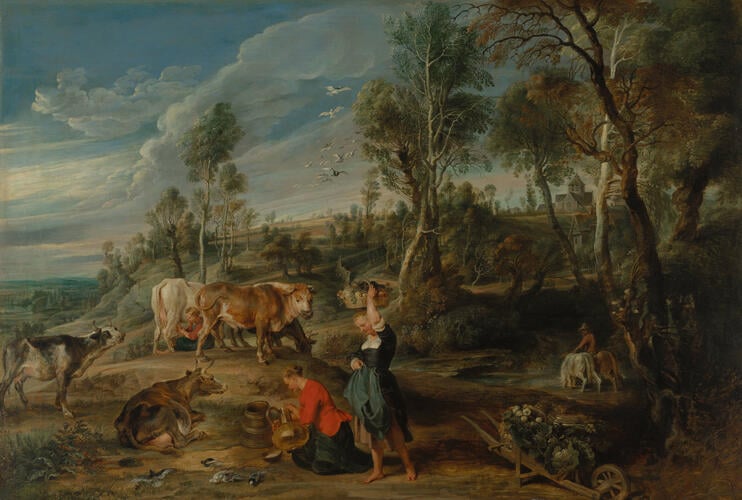-
1 of 253523 objects
Milkmaids with cattle in a landscape, 'The Farm at Laken' c.1617-18
Oil on panel | 85.9 x 125.9 cm (support, canvas/panel/stretcher external) | RCIN 405333
-
This magnificent landscape almost certainly came from Rubens’s own collection. It was described in an inventory drawn up between 1634 and 1649 as a ‘view of Laken’ (a village near Brussels often spelt ‘Laeken’), which is how it acquired its present subtitle. The church in the background with an avenue of trees does resemble (in a generic way) the now destroyed church of Our Lady at Laken (recorded in old photographs), which in the seventeenth century housed a famous relic - a girdle of the Virgin - and was a popular place of pilgrimage, especially for women wishing to conceive. The Archdukes attended processions to the church every year and Albert commissioned a new window for the church following its restoration in 1601. Rubens seems to have included the church in the same way that Brueghel does in his Village Festival (Royal Collection) to suggest that all good things take place with the blessing of the Church and perhaps, in view of the identification of the Archdukes with this particular shrine, under their watchful eye.
Rubens also tries to express these ‘good things’ through a depiction of autumn, when fruits and vegetables are being harvested (the ploughing for next year’s grain crop is just visible on the hillside to the centre left). The figure group here derives from a Rubens Adoration of the Shepherds (Musée des Beaux-Arts, Marseilles), commissioned in 1616 for the church of St John in Mechelen and delivered in 1619. This echo provides a date for The Farm at Laken, but also strengthens the impression that the figures here are used almost as personifications: the central woman is without shoes (indicating idealisation rather than poverty); she resembles a caryatid, bearing a basket of produce on her head, and reads like an allegory of Plenty. In another context one might assume that the kneeling figure was offering a libation at an altar of Pan or some god of the woodlands. The flock of doves dramatically flying out of the picture towards us also conveys the familiar Rubensian idea of Peace, mother of Plenty.
This is one of Rubens’s earliest landscapes; his other essays in the genre at this date were hunts, violent scenes of danger set in wild woodlands - like the Boar Hunt of 1616-18 (Gemäldegalerie, Dresden). It is possible to imagine a pairing of The Farm at Laken and a hunt scene (possibly in Rubens’s dining room) to express the contrast between the activities and terrain, which bring meat and vegetarian fare to the table. If so, this painting becomes a sort of allegory of vegetarian fertility and anticipates Rubens’s depiction of Pythagoras urging his followers to eat vegetables (Royal Collection), also created for his own house.
Like most Rubens landscapes, this one has grown in the making, gaining 15cm to the right, 7cm to the left and 13cm at the top. It is possible to pick out the original painted area with the naked eye: the top-left corner would just have included the bright cumulus cloud formation, the bottom-right corner the wheelbarrow.Provenance
Arnold Lunden (Antwerp), after 1639; from whom bought by L.J.Nieuwenhuys, 1817 (30,000 francs); Aynard Collection; from whom bought by George IV in 1821; added to the inventories of Carlton House dated 1816 (no 583) and 1819 (no 578, where it is valued at an astonishing 1500 guineas); in the Picture Gallery at Buckingham Palace in 1841 (no 97)
-
Medium and techniques
Oil on panel
Measurements
85.9 x 125.9 cm (support, canvas/panel/stretcher external)
112.9 x 154.4 x 9.5 cm (frame, external)
Other number(s)
Alternative title(s)
Milkmaid with Cattle in a Landscape: "The Farm at Laeken"
